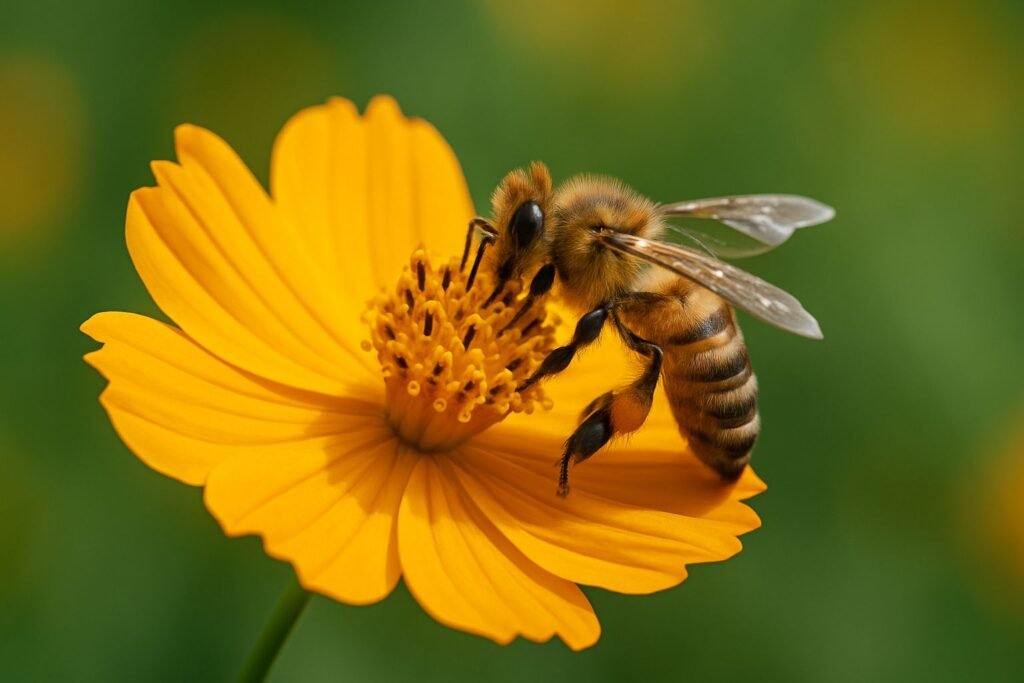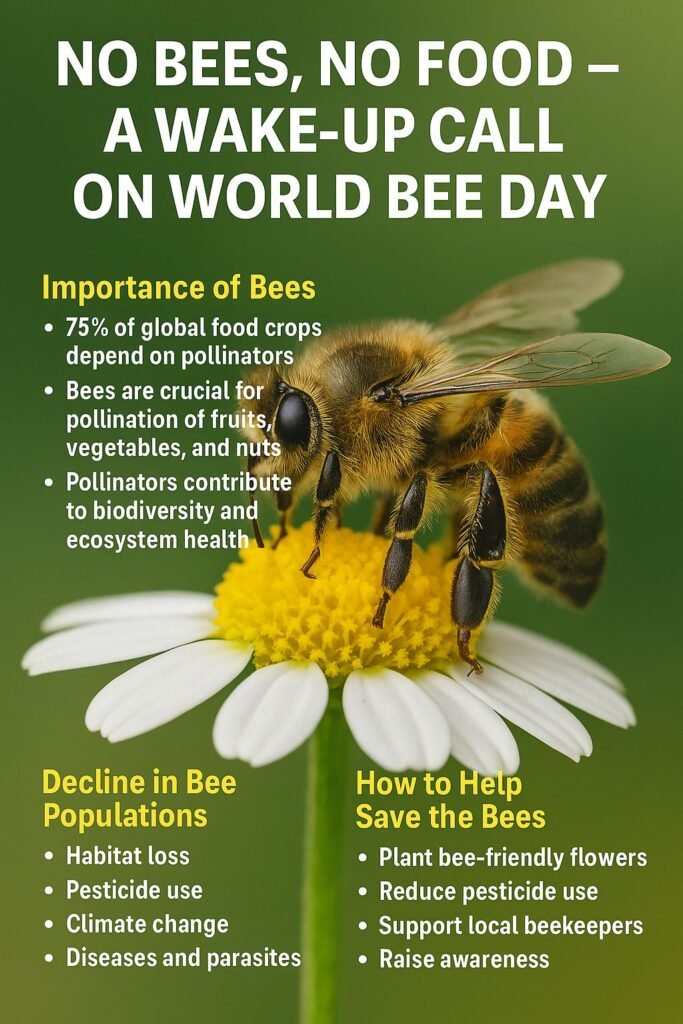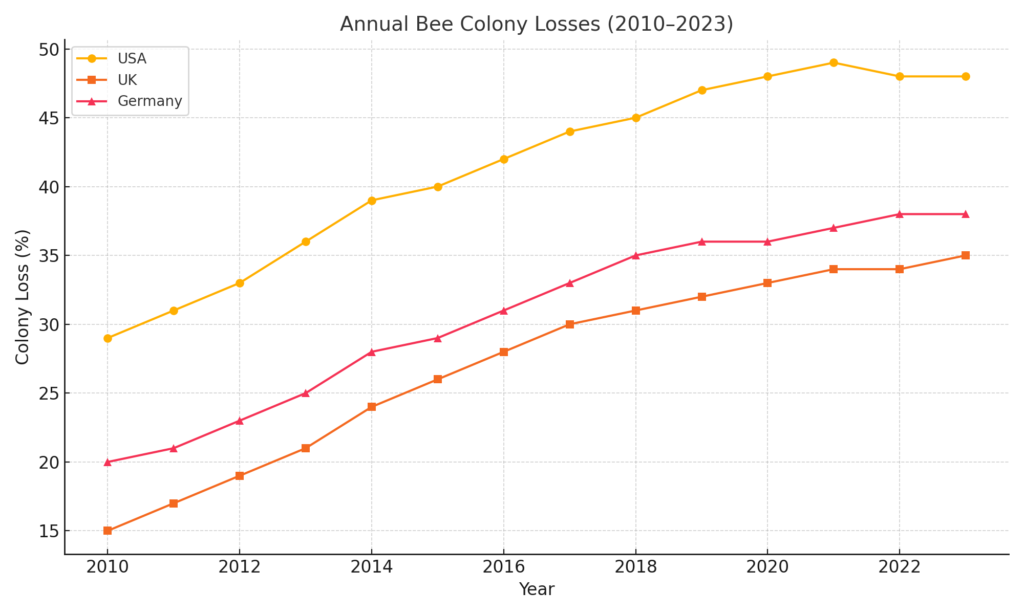
A Future Without Bees Begins with Awareness on World Bee Day
Every year on World Bee Day (May 20), we’re reminded of a sobering reality: bees are vital to global food production. Without their pollination services, we risk losing many of the foods we take for granted—like apples, strawberries, almonds, coffee, and even chocolate. Bees may be small, but their role in supporting food security, biodiversity, and agricultural productivity is enormous.
Today, with bee populations declining at alarming rates worldwide, the phrase “no bees, no food” is no longer a warning—it’s an urgent wake-up call.
Why Bees Matter – The Unsung Heroes of Agriculture

Bees Play a Crucial Role in Pollination
Bees are responsible for pollinating over 75% of global food crops. According to the Food and Agriculture Organization (FAO), bees contribute directly to the production of 87 leading food crops worldwide.
Without pollination, many fruits and vegetables wouldn’t develop properly, leading to smaller yields and reduced quality.
Table: Common Foods That Depend on Bee Pollination
| Food Item | Dependence on Bee Pollination (%) | Notes |
|---|---|---|
| Apples | 90% | Bees enhance size and flavor |
| Almonds | 100% | Entirely dependent on honeybees |
| Blueberries | 90% | Wild bees especially effective |
| Coffee | 30-60% | Boosts bean size and quality |
| Avocados | 80% | Bees increase fruit set rate |
| Cucumbers | 95% | Require cross-pollination |
| Pumpkins | 90% | Squash bees are key pollinators |
Source: USDA, FAO, and Pollinator Partnership Reports
Agricultural Productivity Depends on Healthy Bee Populations
In the United States, bee pollination adds more than $15 billion annually in crop value, supporting major industries like almond farming in California and blueberry production in Maine. In Canada, pollinators contribute over $2 billion CAD to crop production each year.
Across Europe, around 84% of crop species depend on insect pollination, much of it from bees. The European Union has flagged pollinator decline as a threat to food systems and has initiated strategies to promote biodiversity-friendly agriculture.
The Alarming Decline in Bee Populations
Bee Populations Are Declining at an Alarming Rate
Bee colonies have seen record losses in the past decades. Here are some key data points:
- In the U.S., beekeepers reported losing over 48% of honeybee colonies from April 2022 to April 2023 (Bee Informed Partnership).
- In the UK, wild bumblebee populations have shrunk by more than 30% since 1980.
- In Germany, a long-term study found a 75% drop in flying insect biomass over 27 years.

This graph illustrates the steady rise in bee colony losses over the past decade. The USA experienced the highest loss rate, peaking at nearly 50% in recent years. The UK and Germany also show troubling trends, with up to 35–38% of colonies lost annually. These statistics underline the urgency of pollinator protection efforts across the Western world.
Data compiled from reports by the Bee Informed Partnership, UK Centre for Ecology & Hydrology, and European Environmental Agency.
What’s Causing the Decline in Bees?
Several interconnected factors are driving the decline in bee populations:
- Pesticides – Especially neonicotinoids, which impair bees’ navigation and foraging ability.
- Habitat Loss – Conversion of wild landscapes into monoculture farmland strips bees of floral diversity.
- Climate Change – Alters flowering patterns, disconnecting bees from their food sources.
- Parasites and Diseases – Like the Varroa destructor mite, which weakens bees and spreads viruses.
- Pollution – Air pollutants mask the scent of flowers, making it harder for bees to locate them.
Wild Bee Species Are Also in Trouble
Wild bees, such as bumblebees and mason bees, are often more efficient pollinators than honeybees—but they’re even more vulnerable to environmental changes. Of the nearly 4,000 native bee species in North America, over 25% are at risk of extinction (Xerces Society).
What If Bees Go Extinct?
The Consequences of Bee Extinction Are Devastating
If pollinators vanish, we could lose:
- 90% of flowering plants
- One-third of global food crops
- A large portion of nutrient-rich foods (fruits, nuts, and vegetables)
Economic Impact of Pollinator Loss
According to the Intergovernmental Science-Policy Platform on Biodiversity and Ecosystem Services (IPBES), the global economic value of pollination is estimated at $235–577 billion annually. Losses would increase food prices, heighten food insecurity, and damage rural economies.
What Can Be Done – A Call to Action
Farmers Can Protect Pollinators with Bee-Friendly Practices
Here’s what sustainable agriculture can do to help bees thrive:
- Plant flower-rich cover crops and field margins
- Adopt integrated pest management (IPM) to reduce chemical use
- Provide bee nesting habitats like hedgerows and undisturbed soil
- Rotate crops to avoid monoculture depletion
EU-funded programs like “Pollinator-Friendly Farming” offer incentives to farmers using bee-safe techniques.
Everyone Has a Role in Saving the Bees
Simple actions from individuals can make a real impact:
- Grow native, pesticide-free wildflowers
- Install a bee hotel in your garden
- Buy organic, bee-friendly food
- Support local honey producers
- Share bee facts on World Bee Day to raise awareness
Celebrating World Bee Day Across the Globe
What Is World Bee Day and Why It Matters
World Bee Day is observed every May 20th, commemorating Anton Janša, the pioneer of modern beekeeping. It’s a day to honor bees’ essential contribution to ecosystems and global agriculture.
How Countries Celebrate World Bee Day
- USA: Public gardens host “bee walks,” schools hold pollinator projects
- UK: Local councils run bee conservation campaigns and pollinator path programs
- Canada: Beekeeping tours and urban rooftop hive initiatives grow yearly
- EU: Several countries distribute “bee starter kits” for citizen science efforts
Simple Ways to Get Involved in World Bee Day
- Host or join a local pollinator planting drive
- Attend a bee conservation webinar
- Share content using hashtags like #WorldBeeDay, #SaveTheBees
- Educate others—start the conversation at schools, offices, or your blog
Conclusion: A Wake-Up Call We Can’t Ignore
Bees are the heartbeat of our food system. Without them, our plates, our health, and our economy would suffer. World Bee Day reminds us that saving pollinators isn’t optional—it’s essential.
“If the bee disappeared off the surface of the globe, then man would have only four years of life left.” – Misattributed to Einstein, but still a powerful warning.
No bees, no food. It’s time we act like we believe it.